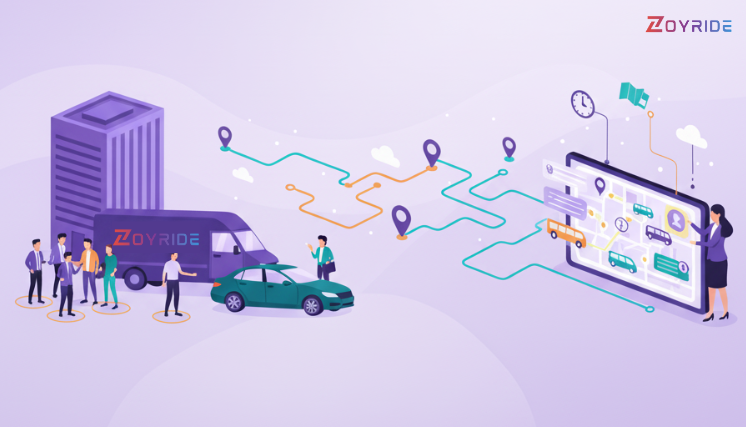
Managing employee transportation is no small task. Between scheduling pick-ups, ensuring driver availability, tracking routes, and keeping costs under control, things can quickly get overwhelming — especially for businesses with multiple locations or large teams.
That’s why more companies are turning to employee transport software. But with so many solutions out there, how do you pick the one that truly fits your needs? Let’s break it down.
Why Employee Transport Software Matters
In today’s workplace, employee satisfaction and safety go hand in hand with operational efficiency. A good transport management system helps businesses:
- Launch white-labeled apps for staff and drivers quickly
- Automate trip scheduling and route planning
- Track vehicles and employees in real time
- Ensure compliance with duty hours and safety guidelines
- Reduce costs by optimizing routes and resources
- Provide employees with a reliable, stress-free commute
- Ease the admin team's finance and accounting operations
The right software isn’t just about moving people from point A to B — it’s about building trust, saving time, and scaling operations smoothly.
In fact, choosing the Best Employee Transport Software can directly improve both employee productivity and overall business efficiency.
Key Factors to Consider When Choosing Software
Choosing the right employee transport software can feel overwhelming with so many options out there. To make it easier, here are the most important factors to look for:
1. Easy for Everyone to Use
If drivers, employees, or admins find the software confusing, it won’t get used properly. Look for a platform with a simple, intuitive interface so onboarding is quick and hassle-free.
2. Automation That Saves Time
The best software should handle routine tasks automatically—like trip scheduling, route planning, and driver assignments. This not only saves admin effort but also reduces errors.
3. Scales as You Grow
Your transport needs today may look very different in a year. Choose a solution that can grow with you—supporting more routes, employees, and vehicles without slowing down.
4. Safety and Compliance Built-In
Employee safety should always come first. Features like driver verification, SOS alerts, live tracking, and automated compliance reporting help keep your operations safe and transparent.
5. Value for Money, Not Just Low Cost
Don’t just go for the cheapest option. Consider long-term value—how much the software saves in fuel, admin hours, or downtime compared to its subscription cost.
6. Smooth Integrations with Your Existing Systems
The software should work well with tools you already use—like HR, payroll, or attendance systems. This avoids duplicate work and keeps all data in sync.
7. Reliable Support and Ongoing Maintenance
Things will break or need updating—it’s inevitable. Make sure your vendor offers responsive support, regular updates, and a clear maintenance plan so your system keeps running smoothly.
8. Flexibility to Match Your Needs
Every business has unique rules for shifts, routes, and policies. Choose software that lets you customize workflows, permissions, and reporting instead of locking you into a rigid setup.
9. Compatibility with Devices and Hardware
Check that the software runs smoothly across different devices (mobiles, tablets, desktops) and works with your existing GPS systems, ID cards, or access hardware.
10. Reputation and Real Customer Feedback
Don’t just rely on sales pitches. Look at customer reviews, vendor track records, and case studies from businesses similar to yours. A reliable reputation often signals better long-term performance.
Steps to Find the Right Fit
- Identify Your Priorities – Is safety your top concern? Or cost reduction? Or scalability?
- Compare Features vs. Needs – Make a checklist and see which provider matches best.
- Request a Demo – Always test the platform before committing.
- Check Reviews & Case Studies – Learn from businesses that already use the software.
- Plan for Growth – Don’t just buy for today, invest in a solution that works 3–5 years down the line.
Conclusion
Choosing the right employee transport software is not just about managing trips—it’s about improving employee satisfaction, saving costs, and ensuring safety across operations.
By focusing on ease of use, automation, scalability, and strong support, businesses can create a transport system that grows with their workforce and delivers real value every day.
This is where Zoyride stands out. With powerful features, flexible customization, and seamless integration, Zoyride helps businesses streamline transport operations while keeping employees happy and secure.
Whether you’re managing daily commutes, large fleets, or scaling to new locations, Zoyride gives you the confidence and control to simplify your transport management.
Investing in the right platform today means fewer challenges tomorrow and a stronger, future-ready employee transport system.
FAQs: Employee Transport Software
Q1. What is employee transport software?
It’s a digital platform that automates scheduling, routing, tracking, and cost management for employee commutes, making transportation safer and more efficient.
Q2. Can small businesses use it, or is it only for large enterprises?
It works for both. Small companies benefit from automation and reduced errors, while large enterprises gain scalability and advanced reporting.
Q3. How does it improve employee safety?
Features like real-time GPS tracking, SOS alerts, verified drivers, and compliance checks ensure a secure travel experience for staff.
Q4. Is employee transport software expensive?
Not necessarily. Many providers offer flexible pricing models based on the number of employees, vehicles, or trips — so businesses can start small and scale as needed.
Q5. Can it integrate with our HR and attendance systems?
Yes, most modern platforms connect seamlessly with HR tools to automate shift-based scheduling and reduce manual effort.
Q6. What industries benefit most from it?
It’s widely used in IT parks, BPOs, hospitals, manufacturing units, and corporate offices — anywhere where staff transportation is a daily need.
Q7. How do I know which is the right software for my company?
Look for ease of use, scalability, safety features, cost transparency, and strong support. Always request a demo before choosing.